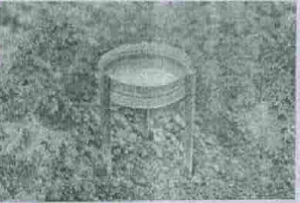Most, if not all field entomologists, will have used Yellow pan traps and been delighted in a horrified sort of way, by the huge number of usually small and hard to identify insects that they attract.
Moericke (Yellow) Pan trap in use in the tropics. http://oilpalmbiodiversity.com/news-update-2/
Moericke (Yellow) Pan trap in use in the far north. http://thebuggeek.com/2010/07/20/my-life-in-the-north-so-far-the-halfway-point/yellow-pan-and-gear/ Many thanks to Crystal Ernst for permission to use this picture.
They are of course, designed to do just that and so as entomologists we should be happy that they are so good at their job. The secret of their success lies in their colour, yellow, which is highly attractive to many flying insects, flies (Disney et al., 1982) and aphids (Eastop, 1955) being particularly attracted to them as are bees and wasps (Vrdoljak & Samways, 2012; Heneberg & Bogusch, 2014). They are also attractive to thrips (Thysanoptera) (Kirk, 1984) and have long been the subject of many comparative studies (e.g. Heathcote, 1957), although the prize for one of the most elaborate and labour intensive studies involving pan traps must go to my friend and former colleague Thomas Döring (Döring et al., 2009) who ran an experiment using pan traps of seventy, yes seventy, different colours! They are easy to deploy and range from expensively bought made-to-order versions to yellow plastic picnic plates, yellow washing up basins and even Petri dishes painted yellow. They can be mounted on poles and sticks or just placed on the ground; to say that they are versatile is a bit of an understatement.
So who invented the pan trap? I have of course given the name of the inventor away in the title of this article. They were invented surprisingly relatively recently, by the German entomologist Volker Moericke (Moericke, 1951), although I suspect that he used them some years before the publication of the paper. These first pan or Moericke traps as we should call them, were made of tin, painted yellow, and mounted on three wooden sticks. They were 22 cm in diameter and 6 cm deep and filled with a mixture of water and formaldehyde . Moericke was working on the aphid Myzus persicae . He was particularly interested in aphid vision and host location (Moericke, 1950). He observed that the aphids were able to distinguish between the red-yellow-green end of the spectrum and the blue-violet end. This then stimulated him to try trapping aphids using coloured pan traps (Moericke, 1951). He observed that the aphids were attracted to the yellow pan traps and behaved as if over a host plant resulting in them landing in the liquid from which they were unable to escape. Although he noted that the traps were extremely effective at catching aphids he did not comment on what other insects he found in the traps.
The first Moericke (yellow) Pan trap (from Moericke, 1951).
This simple, yet effective design has now become an essential part of the entomologist’s tool kit being used by field entomologists of every ilk working across the world in every habitat. They are truly an influential invention and worth of being named an entomological classic. Given the wide usage of these traps and their remarkable efficacy I think that we should make every effort to acknowledge their inventor by calling their modern plastic counterparts Moericke Traps.
References
Disney, R.H.L., Erzinçlioglu, Y.Z., Henshaw, D.D.C., Howse, D., Unwin, D.M., Withers, P. & Woods, A. (1982) Collecting methods and the adequacy of attempted fauna surveys with reference to the Diptera. Field Studies, 5, 607-621.
Döring, T., Archetti, M. & Hardie, J. (2009) Autumn leaves seen through herbivore eyes. Proceedings of the Royal Society B., 276, 121-127.
Eastop, V.F. (1955) Selection of aphid species by different kinds of insect traps. Nature, 176, 936
Heathcote, G.D. (1957) The comparison of yellow cylindrical, flat and water traps, and of Johnson suction traps for sampling aphids. Annals of Applied Biology, 45, 133-139.
Heneberg, P. & Bogusch, P. (2014) To enrich or not to enrich? Are there any benefits of using multiple colors of pan traps when sampling aculeate Hymenoptera? Journal of Insect Conservation, 18, 1123-1136
Kirk, W.D.J. (1984) Ecologically selective traps. Ecological Entomology, 9, 35-41
Moericke, V. (1950) Über das Farbsehen der Pfirsichblattlaus (Myzodes persicae Sulz.). Zeitschrift für Tierpsychologie, 7, 265-274.
Moericke, V. (1951) Eine Farbafalle zur Kontrolle des Fluges von Blattlausen, insbesondere der Pfirsichblattlaus, Myzodes persicae (Sulz.). Nachrichtenblatt des Deutschen Pflanzenschutzdiensten, 3, 23-24.
Vrdoljak, S.M. & Samways, M.J. (2012) Optimising coloured pan traps to survey flower visiting insects. Journal of Insect Conservation, 16, 345-354
Post script
Many thanks to those readers who supplied me with Moericke’s first name, which in the original version of this post was lacking.



